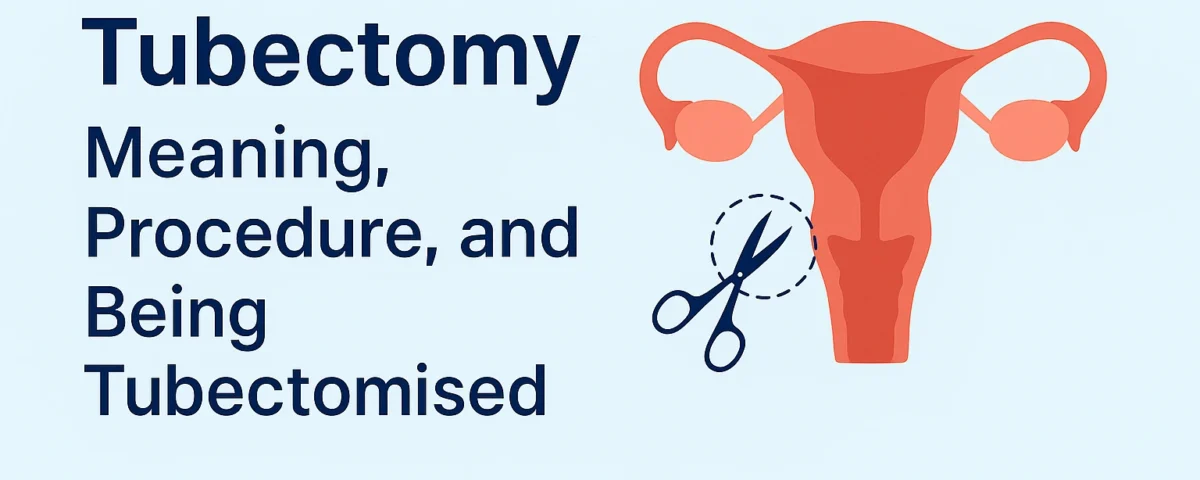Tubectomy: Meaning, Procedure, and Being Tubectomised

PCOD vs PCOS: Full Form, Meaning, and Key Differences Explained
June 12, 2025
Incomplete Abortion: Definition, Causes, Signs, Ultrasound Diagnosis, and Management Explained
June 19, 2025Introduction
Female sterilization is a widely used method of permanent birth control chosen by women who no longer wish to conceive. Among the most common techniques is tubectomy, a surgical procedure that involves blocking or cutting the fallopian tubes to prevent eggs from reaching the uterus for fertilization. Unlike temporary methods of contraception, tubectomy offers a long-term solution with a high success rate, making it a preferred option for women who have completed their families.
Understanding what tubectomy is becomes essential for anyone considering permanent contraception. It’s not just a medical procedure—it’s a life decision that requires awareness of the process, recovery, risks, and long-term effects. Many misconceptions surround female sterilization, often creating confusion or fear. This blog aims to explain the tubectomy meaning, the surgical steps involved, and what it truly means to be tubectomised, so that women can make informed, confident decisions about their reproductive health.
Tubectomy Meaning and Definition
Tubectomy is a medical term used to describe a surgical method of female sterilization. Simply put, tubectomy means the removal or blocking of a woman’s fallopian tubes to prevent the meeting of egg and sperm, thereby avoiding pregnancy. It is a permanent form of birth control and is typically recommended for women who have decided not to have any more children.
To define tubectomy, it is a procedure in which both fallopian tubes are either cut, tied, or sealed to stop the eggs from traveling from the ovaries to the uterus. As a result, fertilization becomes impossible, making pregnancy highly unlikely. The tubectomy meaning goes beyond just the surgical definition—it represents a long-term reproductive choice that offers freedom from temporary contraceptive methods. This method is safe, effective, and often chosen for its simplicity and reliability. However, it requires thorough consultation and informed consent before proceeding.
What is Tubectomy and Why Is It Done?
Here’s a detailed explanation in bullet points to address what is tubectomy and why it is performed:
- What is tubectomy?
Tubectomy is a surgical procedure used to achieve permanent female sterilization by cutting, tying, or sealing the fallopian tubes. - Explain tubectomy in simple terms:
It prevents the eggs from reaching the uterus, thereby stopping fertilization and pregnancy. - Role in permanent contraception:
Tubectomy is a long-term solution for birth control, offering high effectiveness without the need for ongoing contraceptive methods. - Why doctors recommend it:
Doctors suggest tubectomy for women who have completed their family or have medical conditions that make pregnancy risky. - When is tubectomy performed?
It can be done shortly after childbirth (postpartum sterilization), during a cesarean section, or as a scheduled surgery at a later time. - Patient consent and counseling:
The procedure is only done after thorough counseling and informed consent from the woman.
Tubectomy Procedure: Step-by-Step Overview
The tubectomy procedure is a straightforward and widely performed surgical method for permanent female sterilization. Before undergoing the tubectomy operation, patients are advised to attend a pre-operative consultation that includes medical evaluation, counseling, and consent. Blood tests, urine analysis, and sometimes imaging may be conducted to ensure the patient is fit for surgery.
During the tubectomy surgery, the patient is placed under local or general anesthesia. The surgeon accesses the fallopian tubes through small abdominal incisions. Depending on the method chosen, the tubes are either cut, tied, clipped, or sealed using electrical current. The two most common types of tubectomy are:
- Laparoscopic Tubectomy: A minimally invasive technique using small incisions and a laparoscope (a thin tube with a camera).
- Mini-laparotomy: A slightly larger incision is made, usually just above the pubic area, often used post-delivery.
Both methods are safe, quick, and highly effective when performed by qualified specialists.
What Does It Mean to Be Tubectomised?
Being tubectomised means that a woman has undergone a permanent sterilization procedure to prevent pregnancy. While the surgery is safe, recovery is an important phase that includes post-operative rest, avoiding strenuous activity, and monitoring for any signs of infection.
Most women can return to their normal routine within a few days. Doctors typically advise avoiding heavy lifting and sexual activity for at least one to two weeks after the procedure. Mild abdominal discomfort or bloating is common but temporary.
Long-term, being tubectomised does not affect hormone levels, menstrual cycles, or overall health. However, it is a permanent decision, so thorough counseling is vital. Women should also maintain regular gynecological checkups and adopt a healthy lifestyle post-surgery for overall well-being.
Risks and Benefits of Tubectomy
Benefits:
- ✅ Permanent birth control: Tubectomy offers a lifelong solution for contraception without the need for pills or devices.
- ✅ Cost-effective: It’s a one-time procedure, eliminating the ongoing cost of temporary contraceptives.
- ✅ No hormonal side effects: Unlike some birth control methods, it does not affect hormonal balance or menstrual cycles.
- ✅ Quick recovery: Minimally invasive techniques like laparoscopic tubectomy allow for faster healing and minimal downtime.
Risks:
- ⚠️ Bleeding or infection: As with any surgery, there’s a small risk of internal bleeding or post-operative infection.
- ⚠️ Anesthesia-related complications: Rare but possible during the tubectomy operation.
- ⚠️ Regret in younger women: Women below 30 who opt for sterilization may experience regret if they later change their mind about having children. Counseling through an expert in Obstetrics and Gynecology is advised.
Myths and Misconceptions About Tubectomy
- ❌ Myth: Tubectomy affects sexual function
✅ Fact: Tubectomy does not interfere with libido, sexual pleasure, or hormone levels. In fact, many women report improved confidence post-surgery, often complementing treatments like Cosmetic Gynecology. - ❌ Myth: Tubectomy is easily reversible
✅ Fact: Tubectomy is considered a permanent procedure. Reversal is complex and not always successful. If unsure, consult an Infertility Clinic before deciding. - ❌ Myth: It causes early menopause
✅ Fact: Tubectomy has no effect on a woman’s hormonal system or the timing of menopause. - ❌ Myth: It’s only for older women
✅ Fact: While age is a factor, tubectomy is based on completed family planning, not just age. It’s suitable for women confident in their reproductive decisions.
When Should You Consider Tubectomy?
- ✅ Medical guidance: Tubectomy should only be considered after a thorough consultation with a qualified specialist in Obstetrics and Gynecology. It is recommended for women who are certain they do not wish to have more children or have health conditions where future pregnancies may pose a risk.
- ✅ Age and family planning considerations: While there is no fixed age, tubectomy is typically advised for women above 30 who have completed their family. Younger women may be more prone to regret, so doctors emphasize proper counseling and long-term planning. Alternatives can be discussed at an Infertility Clinic for those unsure about future pregnancy.
Conclusion
In summary, tubectomy is a safe and effective form of permanent female sterilization. Understanding the tubectomy meaning, its procedure, recovery, and long-term outcomes can help women make empowered choices regarding their reproductive health. The tubectomy surgery offers freedom from temporary contraceptives and brings peace of mind for those who are confident in their family planning decisions.
Being tubectomised does not affect your femininity, hormonal balance, or sexual well-being. However, it’s a decision that should be made after careful thought and medical advice. For those also exploring intimate wellness or post-childbirth concerns, options like Cosmetic Gynecology may complement this journey.
Always prioritize informed decision-making, guided by professionals, to ensure your health, future, and lifestyle align with your reproductive goals.
FAQs
What is tubectomy surgery?
Tubectomy surgery is a permanent method of female sterilization, commonly chosen by women who no longer wish to conceive. The procedure involves cutting, tying, or sealing the fallopian tubes to block the path between the ovaries and uterus, thereby preventing fertilization. It is usually performed under local or general anesthesia and can be done via laparoscopy or mini-laparotomy. Tubectomy is considered a safe, reliable, and effective birth control option. While it doesn’t affect a woman’s hormonal balance or menstrual cycle, it is irreversible in most cases, making thorough medical counseling essential before opting for the surgery.
Can we get pregnant after a tubectomy?
While tubectomy is a highly effective form of permanent contraception, pregnancy after the procedure is extremely rare but not entirely impossible. In rare cases, the fallopian tubes may naturally reconnect over time or the procedure may fail due to technical issues, leading to a small chance of pregnancy. If pregnancy does occur post-tubectomy, there’s a higher risk of it being ectopic (outside the uterus). Women who later wish to conceive must explore alternatives like IVF. Therefore, thorough counseling is essential before undergoing tubectomy to ensure it aligns with one’s long-term reproductive goals.
Do we get periods after a tubectomy?
Yes, you will continue to get your periods after a tubectomy. The procedure only blocks or removes the fallopian tubes, which are responsible for carrying eggs from the ovaries to the uterus. It does not affect the hormonal cycles that regulate menstruation. Your ovaries will still release eggs and produce hormones like estrogen and progesterone, ensuring that your menstrual cycle remains unchanged. Many women mistakenly believe tubectomy causes menopause or period stoppage, but this is a myth. Tubectomy is solely a method of birth control and has no impact on menstruation or hormonal balance.
Is tubectomy 100% safe?
Tubectomy is generally considered a safe and low-risk surgical procedure when performed by qualified professionals. However, like any surgery, it carries some potential risks such as bleeding, infection, or complications from anesthesia. In very rare cases, the procedure may fail, leading to unintended pregnancy or ectopic pregnancy. Additionally, younger women may later regret the decision if their reproductive goals change. While it is over 99% effective and commonly practiced, it is crucial to have proper medical counseling through a trusted Obstetrics and Gynecology specialist to weigh the risks and benefits before choosing tubectomy.




